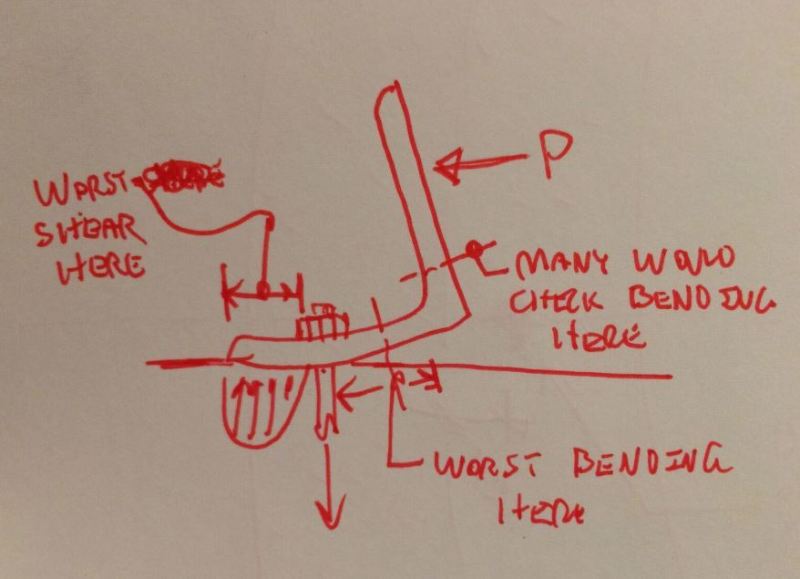Gents! Please take a look at the attachments I posted. This problem is kind of confusing and it doesn't mention where this comes from. If you guys are familiar with this scenario please let me know. Sx is the section modulus, Zx is some kind of axis? But where is FyZx less than or equal to 1.6My.
Navigation
Install the app
How to install the app on iOS
Follow along with the video below to see how to install our site as a web app on your home screen.
Note: This feature may not be available in some browsers.
More options
Style variation
-
Congratulations MintJulep on being selected by the Eng-Tips community for having the most helpful posts in the forums last week. Way to Go!
You are using an out of date browser. It may not display this or other websites correctly.
You should upgrade or use an alternative browser.
You should upgrade or use an alternative browser.
PE exam practice test Question 528 2
- Thread starter Leftwow
- Start date
- Status
- Not open for further replies.
Lomarandil
Structural
I can't see your attachments.
But for checks that allow the use of plastic moments and Zx (the plastic modulus), it is typically limited to 1.6*Sx
For example, AISC weak axis bending of I shapes, Mp = FyZy <= 1.6FySy (F6-1)
(My is the yield moment = FyS)
But for checks that allow the use of plastic moments and Zx (the plastic modulus), it is typically limited to 1.6*Sx
For example, AISC weak axis bending of I shapes, Mp = FyZy <= 1.6FySy (F6-1)
(My is the yield moment = FyS)
- Thread starter
- #3
I second Lomar. Zx is your plastic modulus while Sx is your elastic modulus. OP is talking about the problem where a point load is applied to an angle and you're asked maximum load that can be applied to angle. Similar to designing a brick lintel.
- Thread starter
- #6
structSU10
Structural
it is a simple problem. they want you to check the leg of the angle for bending and shear. They don't try to trick you with these questions.
- Thread starter
- #8
-
1
- #9
Yes, that is what your supposed to get from the assumptions and why they mention that the load is distributed along the length. It's just a simple check of bending of a flat bar asked in a surprisingly practical way. The only real trick is knowing the plastic modulus formula for flat bars. I don't know if the CERM has a table for that, but I think that would be the part that would trip most people up.
-
1
- #10
I sometimes have trouble deciding what they want on these "simple" questions. Occasionally there is discrepancy between what I think examiners expect to see and what I think is the most appropriate solution. Per the sketch below:
1) I bet a lot of engineers would look at bending in the vertical leg.
2) The difference is pretty small but, technically, max bending is in the horizontal leg between the bolt and fillet.
3) The max shear is left of the bolt as a result of prying action. Presumably they don't want you to check shear as a) it's unlikely to govern and b) who the heck knows what the distribution of compression block force really is.

I like to debate structural engineering theory -- a lot. If I challenge you on something, know that I'm doing so because I respect your opinion enough to either change it or adopt it.
1) I bet a lot of engineers would look at bending in the vertical leg.
2) The difference is pretty small but, technically, max bending is in the horizontal leg between the bolt and fillet.
3) The max shear is left of the bolt as a result of prying action. Presumably they don't want you to check shear as a) it's unlikely to govern and b) who the heck knows what the distribution of compression block force really is.

I like to debate structural engineering theory -- a lot. If I challenge you on something, know that I'm doing so because I respect your opinion enough to either change it or adopt it.
canwesteng
Structural
I think the worst bending only occurs between the bolt and the fillet if some substantial deflection occurs in the angle, like in your sketch, but otherwise worst case bending is at the heel and is constant between the heel and the bolt.
- Thread starter
- #13
- Thread starter
- #14
- Status
- Not open for further replies.
Similar threads
- Replies
- 5
- Views
- 7K
- Replies
- 2
- Views
- 1K
- Locked
- Question
- Replies
- 8
- Views
- 696
- Locked
- Question
- Replies
- 14
- Views
- 3K
- Locked
- Question
- Replies
- 17
- Views
- 3K
